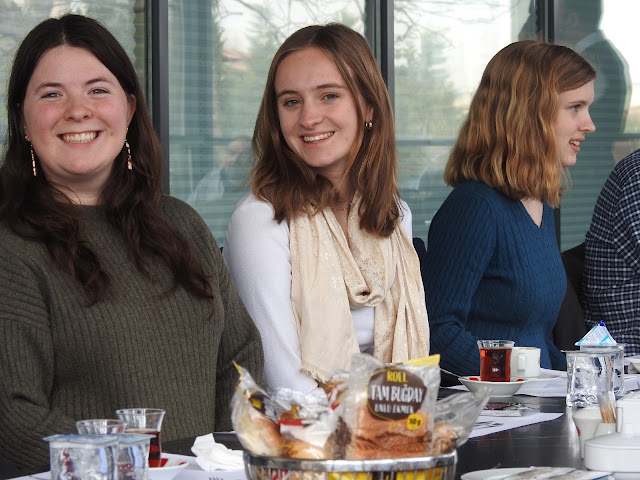We began today by heading on a bit of a walk to the Neve Shalom, which is the largest and most popular out of the 25 operating synagogues in Istanbul. The Neve Shalom can be translated from Hebrew and Arabic to mean “Oasis of Peace,” and was built in the late 1930s to accommodate an increase in the Jewish population. It is open to service for Shabbats, bar mitzvahs, and other important events. Similar to mosques, the Neve Shalom has a balcony for gender segregated seating depending on the type of service being offered.
 |
| View from above of the Neve Shalom Synagogue |
 |
| Another closer view |
Upon arrival, we began by talking a bit about the history of religious tensions towards the Jewish community across time, where we learned the Neve Shalom was only recently opened again due to the conflict in Israel. In response to these tensions the Jewish community have been subject to overtime, we took note of the hard hats kept under the seats in case dangerous situations were to arise, as well as the strict security and policies in place at the Neve Shalom. We also observed how since Istanbul is a cosmopolitan city, this can be both an opportunity and a threat to the Jewish community as while a diversity of religions is accepting and allows them a place to exist, there is often likely a feeling of competition or dislike that can cause tensions.
We also talked a bit about the origins of Judaism here. In early times, there were many instances of expulsions from Judea to Asia Minor such as the Babylonian exile that took place in the 6th century BCE. The capture of Jerusalem by Babylonians resulted in an expulsion of many Jews from Judea, which led many to go over to Asia Minor. Events such as these caused a dispersal of Jews among the ancient world and was also accompanied by a spread of Christianity. This is evidenced in 1492 when Catholic Monarchs Isabella and Ferdinand initiated the reconquest of Spain causing practicing Jews and Muslims to be expelled from the country, thus catholicizing the Iberian Peninsula. This caused many Jews to either convert to Christianity or migrate to the Ottoman Empire, where a prominent part of the Jewish population in present day Istanbul originated from. As of recently, Spain and Portugal are now offering citizenship to people with Sephardic Jewish ancestry subject to these expulsions, with the intention to right their wrongs.
Adjacent to the Neve Shalom is the Jewish Museum, which was a relatively small museum featuring many descriptions of Jewish holidays, symbols, and traditions to lay a groundwork of what Judaism is for those who are unfamiliar. At this museum, there were several examples of confluence, including this hanukkiah (see image below) that is in the shape of a minaret which is a traditionally used tower built at mosques to call Muslims to prayer. It was particularly interesting to see this as it combines two prominent religious symbols and was likely depicted as such because the meaning of a menorah is “light” and a minaret meaning “lighthouse”.
 |
| Me and Dr. Huber enjoying the hanukkiah shaped like a minaret |
At the museum, we were also able to see a rolled Torah, which is the foundation of Judaism that contains five books written by the Prophet Moses and then, as part of Jewish tradition, inscribed fully by hand by trained people on parchment made by kosher animal skin. These rolled Torah books are often read in synagogues and kept in the most sacred place of a synagogue.
After leaving the Jewish Museum, we took a walk through the Galata district to reach the Galata Tower. First built by Emperor Justinian in the 6th century and eventually destroyed by the Byzantines, it was later rebuilt by the Genoese in 1348. By the Genoese, it was built to serve as a watchtower for the Italians to maintain surveillance of the Byzantines and to guard the northern approach to the Golden Horn. Later, after the Ottoman conquest, it became a jail, and now, it is being used as an observatory that allows people to visit as high as the balconies, unless under renovation such as they were today. Nevertheless, we were able to ascend 7 stories and see the breathtaking views of the city and the vantage point the Italians used during the crusade.
 |
| Galata Tower |
 |
| View from the Galata Tower |
Overall, today was a great day to wrap up the content of our course and we look forward to enjoying our last day and farewell dinner tomorrow before we say hoşçkal (goodbye) to Türkiye.


















































